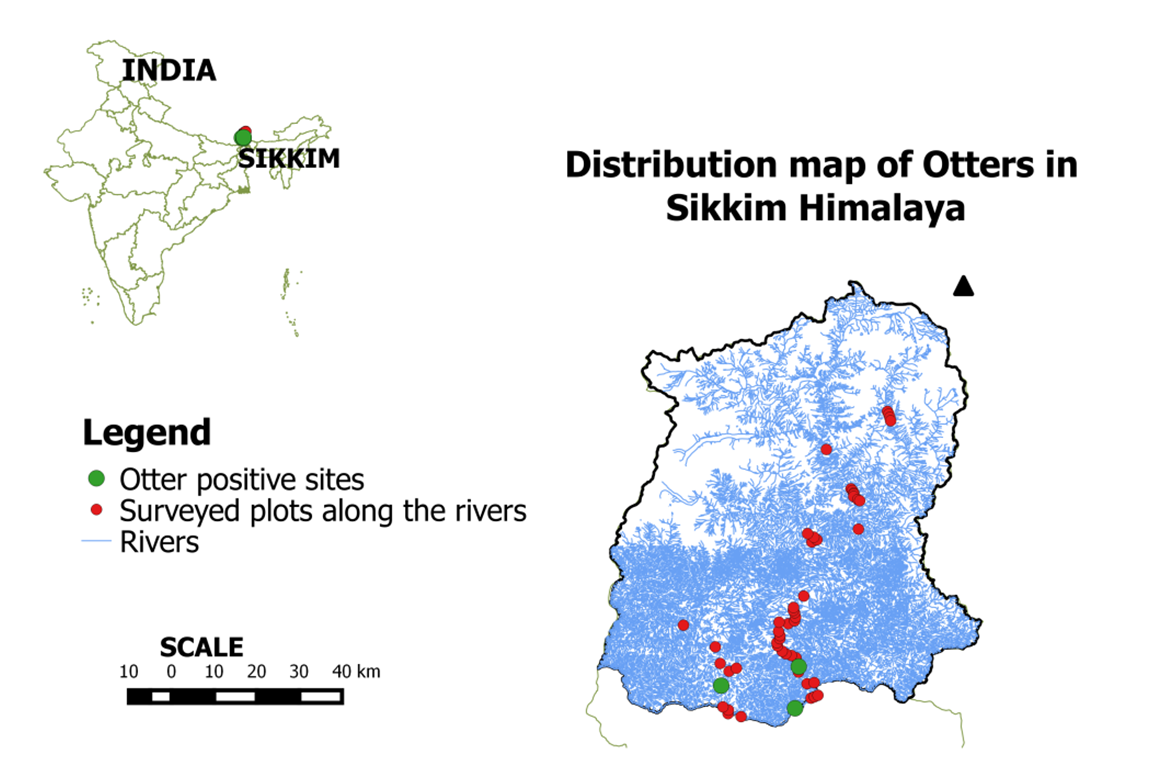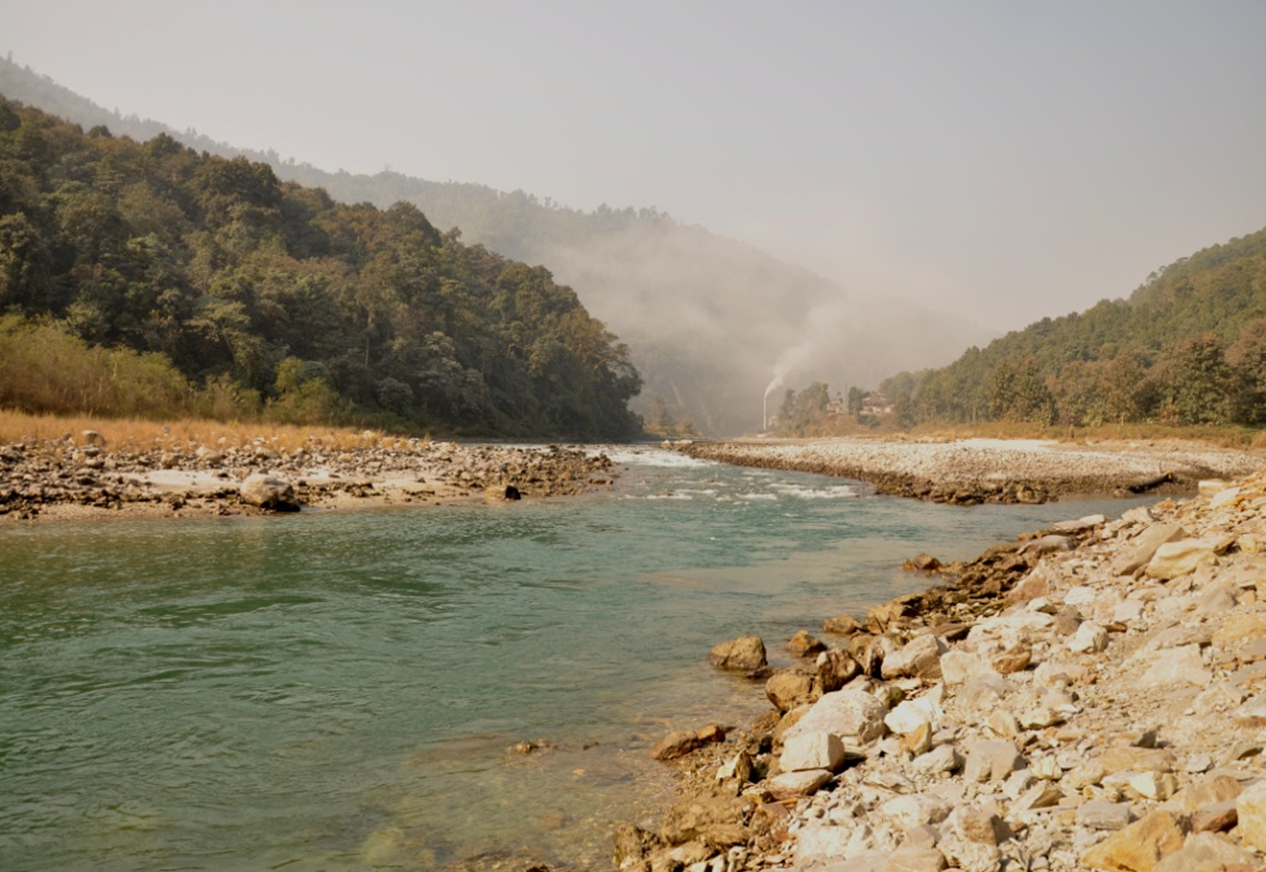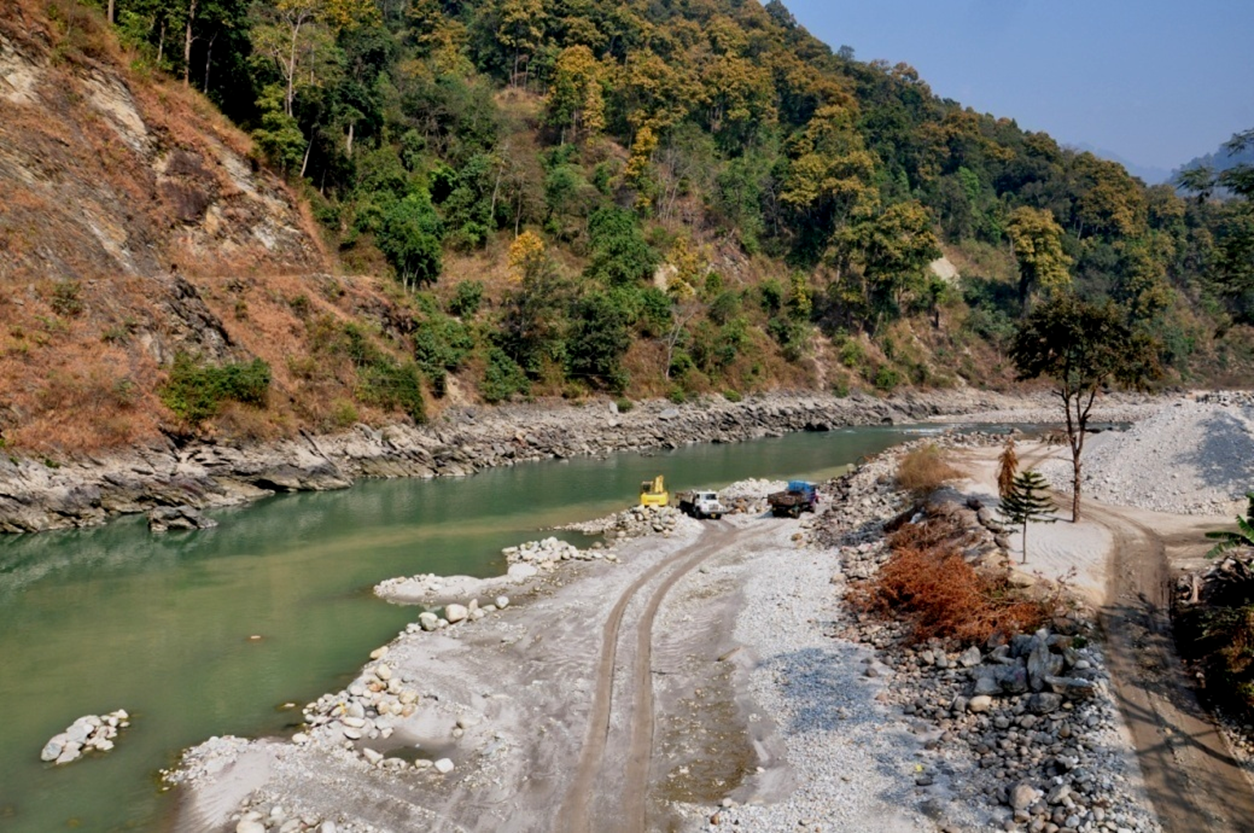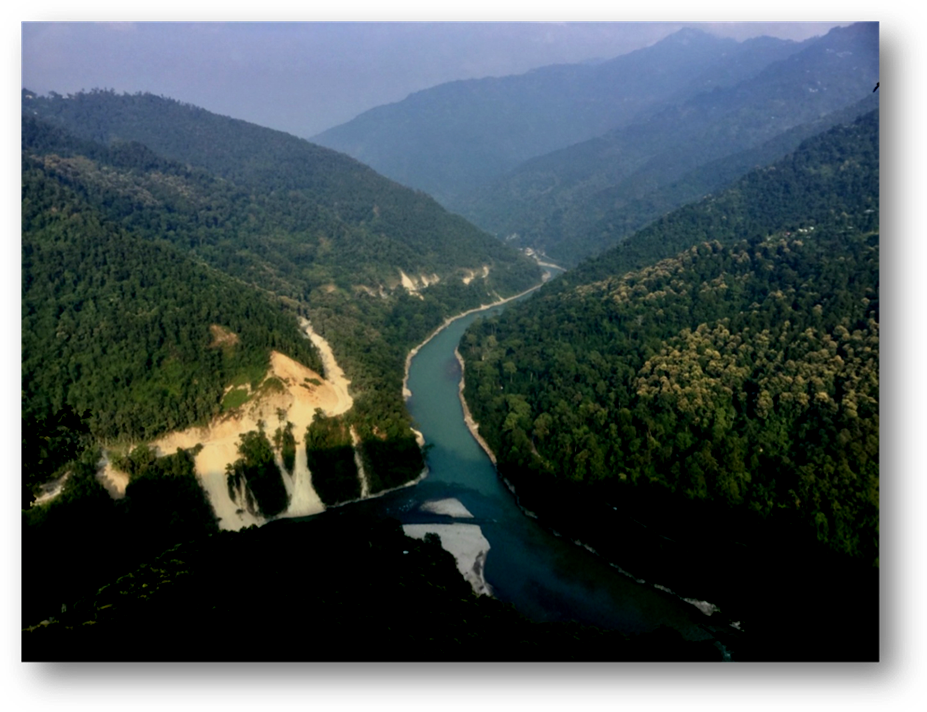IUCN/SSC Otter Specialist Group Bulletin

©IUCN/SCC Otter Specialist Group
Volume 37 Issue 4 (December 2020)
Citation: Khatiwara, S. and Bhutia, K.C. (2020). A Distribution Survey For Otters In Sikkim, India. IUCN Otter Spec. Group Bull. 37 (4): 212 - 218
A Distribution Survey For Otters In Sikkim, India
Sunita Khatiwara and Karma Choden Bhutia
Forest and Environment Department, Government of Sikkim, Gangtok, Deorali – 737102, India
Corresponding Author: Email: sunitakhatiwara@gmail.com
Received 22nd October2019, accepted 25thMay 2020
Abstract: Little research or conservation attention has been directed towards otter species in the rich biological assemblages in the Eastern Himalayan region of India. We present the findings from the first physical and social survey of otters in the Indian State of Sikkim. We searched riverbanks along the major river of Sikkim, the Teesta River, and three of its tributaries, the Rangit, Lachen and Lachung for scats, tracks, dens and latrines of otters. We quantified 1) bankside vegetation cover and substrate, and 2) levels of human disturbance to habitat. Awareness programs were conducted in villages and schools adjacent to surveyed river stretches, and residents were queried about their familiarity with otters. We found very little evidence of otter presence on the banks of major rivers in Sikkim, from either the physical or social surveys, which may be attributed to increasing habitat degradation and little familiarity with otters among local people, particularly in the younger generation.
Keywords: Otters, Sikkim, India
INTRODUCTION
Three species of otter have been reported in the Eastern Himalayas region (Das, 2010; Choudhury, 2013; Talukdar and Choudhury, 2017), but thus far, no systematic studies particularly on otters in the small Indian state of Sikkim. Sikkim is a part of the Eastern Himalayan biodiversity hotspot (Myers et al., 2000). Most conservation work in the region, however, focuses mostly on large and charismatic species, neglecting the small but ecologically important group of small mammals, including the otters.
Otters are little studied in Sikkim due to its remote location and rugged and steep terrain. There is scanty mention of Eurasian otter (Lutra lutra) (Biswas and Ghose, 1982; Ghose et al., 2014), Small-clawed otter (Aonyx cinereus) and Smooth coated otter (Lutrogale perspicillata) (Choudhury, 2013) presence in Sikkim. There has been only one confirmed record of a live Eurasian otter in Sikkim in recent decades on 2 November 2018 (http://epaper.sikkimexpress.com/date/2018-11-02/), officers and staff of the Forest and Environment Department rescued, rehabilitated, and released a female Eurasian otter found in a small hill stream near the village of Malling, Mangan (N 27.49808 ̊; E88.54851 ̊) at an elevation of 1442 m asl in northern Sikkim.
This study aims to address the knowledge gap hindering conservation of otters in Sikkim by conducting a systematic otter survey and by assessing human threats to otter habitat. I present data on a physical survey of otters in the major river of Sikkim, the Teesta, and three of its tributaries. Awareness programs were conducted for local villagers, who were asked about their familiarity with otters.
STUDY AREA
Sikkim is a small, mountainous state in the north of India (7,096 km2); Bhutan lies to the east, Nepal to the west, and China to the north. An immensely rich biological diversity is fostered by the many eco-climatic niches along the state’s steep elevation gradients from 300 m asl in the lowland plains to 8,598 m asl at Mt. Kanchendzonga.
The Teesta (Fig. 1) is the largest river in Sikkim, originating from glaciers in North Sikkim at an elevation of about 5,200 m asl. It collects numerous tributaries in its descent, including the Rangit River, Zemu Chu, Lachung Chu, Rangyong Chu, Dik Chu, Rani Khola, and Rangpo Khola. The Rangit is the largest tributary, originating in the mountain peaks of West Sikkim and joins the Teesta at the southern border with the State of West Bengal. The seasonal flows of these rivers are highly variable, and depend on snowmelt from the Tibetan Plateau and surrounding mountain ranges, together with a long monsoon season. The Teesta and Rangit River stretches surveyed were mostly low-elevation, ranging mostly between 200m and 400 m asl. The two higher elevation tributaries of the Teesta surveyed the Lachen and the Lachung Chu, flow from 4,500 to 1,200 m and joins the river Teesta at the small town of Chungthang. River banks were generally rock-strewn, with cobbles or boulders.
METHODS
We followed a sampling protocol used in the western and central Himalayas (Jamwal et al., 2016; Chettri and Savage, 2014), recording indirect otter signs, comprising tracks, scats, latrines, and dens, and human disturbance variables. Plots were placed 900 m apart along one bank of each river, and were 100 m by 10 m, adjacent to the river edge, for a 1,000 m2plot. The survey was conducted over three and half weeks in January and February, 2017. High water flow during the monsoon in Sikkim, up to 8 months of rain, leaves a small window for sampling in winter months.
As the survey proceeded, it became apparent that otter signs were scarce, so if the terrain allowed, additional observations were made along the transect between plots. This was possible on the Teesta and Rangit Rivers, but not on the Lachen and Lachung Chu, where extremely steep and challenging terrain may have led to some otter sign being missed. Vegetation cover was classified in categories of bare, light, medium, moderate, and dense. Bank substrate was classified into categories of sand/mud, cobbles, small rock, large rock, and boulders. Habitat disturbance was recorded as none, light, moderate, or severe.
Presentations on otter ecology were made in villages and schools to make local people aware of the value of otters. We distributed an informative poster, and flashcards of otters and other wildlife, to school teachers, students and local villagers and delivered oral presentations on the biodiversity of Sikkim and the important role that otters play in aquatic ecosystems. Community members and school children were asked if they recognized otters and if they had seen them recently or in the past.
RESULTS
Otter Sign and Habitat Characteristics
A total of 82 plots were sampled: 41 plots along the mainstream Teesta River, 27 plots along the Rangit, 10 plots along the Lachen, and 4 plots along the Lachung Chu. Very little otter sign was found along the Teesta and Rangit Rivers. I recorded only four otter positive sites on surveyed stretches of Teesta River (scat = 2, latrines = 1, tracks = 1) and five positive sites from Rangit River (scat = 4, latrines = 1). No otter dens were identified. Only one otter track was documented, on the bank of the Teesta. River banks on all transects were extremely rocky, and that together with fluctuating water levels, contributed to a lack of track impressions. The small sampling effort conducted in North Sikkim, on two tributaries of the Teesta, small mountain streams that flow swiftly on steep gradients at much higher elevations, yielded no sign of otters. The otter sign locations on the Teesta and Rangit Rivers are shown in Figure 2.

The banks of all sampled rivers were overwhelmingly bare of vegetation; 98 % of plots on the Teesta (40 of 41), 89% on the Rangit (23 of 26 plots), 80% on the Lachen (8 of 10) and 50% on the Lachung Chu (2 of 4), had between 0 and 5% vegetation cover. As a result, the river banks, whether narrow or wide, were dominated of rocks of various sizes. Bankside substrate was largely comprised of cobble and large rocks with numerous large boulders and very few sandy areas.
Habitat Disturbance
We investigated human disturbance threats on a small scale along the selected study rivers. Human disturbance along river banks was measured by factors such as abundance of dog and cow tracks, trash, sand mining, nearby industry, dams, bankside human tracks and roads and proximity to houses (Fig. 3). Along the main river of Sikkim, the Teesta, more than two-thirds of the plots showed severe human impacts (none = 9%; light = 9%; moderate = 15%; severe = 68%) (Fig. 4). Along the Rangit River, more than half the plots showed no sign of disturbance, but more than a quarter showed severe impacts (none = 58%; light = 8 %, moderate = 8 %; severe = 27 %). Along the two high elevation tributaries, there was almost no human disturbance.

Social Survey
We asked community members in 80 villages, engaging 3,300 individuals from age 18 to 89 years about their familiarity with and observations of otters. Of this group, the forty respondents who recognized otters reported noting a decreasing trend in otter sightings over the last decade. Senior citizens appeared to have some knowledge about otters, but younger villagers were unfamiliar with the species. I also conducted awareness and outreach activities in five schools in villages along the surveyed rivers, querying 180 students from age 6 to 16 about their knowledge of otters. Only 6 students reported knowledge of otters and their habitat.
Threats to Otters
Despite the abundance of rivers and wetlands in the Eastern Himalayas, otters still face numerous threats in the region. Otter populations across South Asia are in steep decline ( Duplaix and Savage, 2018) owing to rising human populations, habitat fragmentation, decreasing water quality and quantity, loss of adequate prey base and the illegal pelt and pet trade (Gomez et al., 2016; Gomez and Bouhuys, 2018). In Sikkim, severe human disturbances to otter habitat include hydroelectric dams, sand mining, pollution, and stone quarrying. A particular threat comes from habitat fragmentation and alteration created by the high concentration of existing and planned hydroelectric dams. The Teesta River currently has two large and three smaller hydroelectric dams, and the Rangit River has one large dam. Large portions of rivers will be diverted into tunnels during construction, disrupting aquatic ecosystem dynamics (Fig. 4). In addition, the steepness of most of Sikkim’s landscape means that towns discharging urban pollution, as well as pharmaceutical, tanning, and distilling industries, tend to be concentrated on the flanks of riverbanks.

DISCUSSION
Otter populations in Sikkim, India appear to be extremely rare and highly threatened. The presence but extreme scarcity of otter sign along the Teesta and Rangit Rivers, and a captured Eurasian otter, indicate that while otters still inhabit Sikkim’s two main rivers, their populations are very low. Impressions recorded from older citizens suggest that otter populations may be dwindling in the big rivers and are perhaps already extirpated from the highly disturbed tributaries. Threats to otter habitat are only increasing in the state, as population rises, water quality declines, and more planned dams disrupt continuous habitat. Water quantity in Sikkim’s rivers is also likely to decline in the future as climate warming diminishes the glaciers that feed rivers.
There is a compelling need for a conservation strategy for otters in Sikkim. Wildlife management agencies at the state and national level, together with the network of Himalayan otter researchers and conservationists, urgently need to develop and implement a strong plan for the protection and recovery of otter populations. Without such a protective strategy, it seems unlikely that otters will persist in Sikkim in the near future.
Acknowledgements: We thank Wildlife Reserve Singapore and Rufford Foundation for funding the study. We are also would like to thank Forest and Environment Department, Government of Sikkim for providing the research permit. Our sincere thanks to Prof. Melissa Savage and IUCN Otter Specialist Group members for mentorship and guidance. Furthermore, we thank the field team members namely Dawa Thendup Sherpa, Rutujha Dhamale, Dharmendra Lamsal, Andrew Chettri and Binita Khatiwara for helping with the field work in the tough mountain river terrain and reviewers for extremely valuable suggestion on the manuscript.
REFERENCES
Biswas, B., Ghose, R.K. (1982). Progress report on pilot survey of the World Wildlife Fund-India/Zoological Survey of India collaborative project on the status survey of the lesser cats in eastern India. Zoological Survey of India, Calcutta, India.
Chettri, P., Savage, M. (2014). A distribution survey for otters along a river in Central Bhutan. IUCN Otter Spec. Group Bull. 31(2): 65-74.
Choudhury, A. (2013). The mammals of North east India. Gibbon Books and the Rhino Foundation for Nature in NE India, Guwahati, Assam, India.
Das, C. (2010). First Record of Eurasian Otter (Lutra lutra) in Rajiv Gandhi Orang National Park, Assam. Tigerpaper 37(3): 32
Duplaix, N., Savage, M. (2018). Global Otter Conservation Strategy. IUCN Otter Spec. Group Publication. 168 pp.
Ghose, P.S., Shrestha, P., Theengh, L.T., Pintso, T., Shar, B.K. (2014). Records of small carnivores in Barsey Rhododendron Sanctuary, Sikkim, India. Small Carnivore Cons. 51:42-45.
Gomez, L., Leupen, B.T.C., Theng, M., Fernandez, K., Savage, M. (2016). Illegal Otter Trade: An Analysis of Seizures in Selected Asian Countries (1980-2015). TRAFFIC, Petaling Jaya, Selangor, Malaysia.
Gomez, L., Bouhuys, J. (2018). Illegal otter trade in Southeast Asia. TRAFFIC Report, Petaling Jaya, Selangor, Malaysia. 51 pp. http://epaper.sikkimexpress.com/date/2018-11-02/
Jamwal, P. S., Takpa, J., Chandan, J., Savage, M. (2016). First systematic survey for otter (Lutra lutra) in Ladakh, Indian Trans Himalayas. IUCN Otter Spec. Group Bull.33(2): 79-85.
Myers, N., Mittermiler, R.A., Mittermiler, C.G., Gustava, A.B., Da Foseca, Kent, J.(2000). Biodiversity hotspots for conservation priorities. Nature. 403:853-858
Roos, A., A. Loy, de Silva, P., Hajkova, P., Zemanova, B. (2015). Lutra lutra. The IUCN Red List of Threatened Species 2015: e.T12419A21935287
http://dx.doi.org/10.2305/IUCN.UK.2015-2.RLTS.T12419A21935287.en.Downloaded on September 13, 2019.
Talukdar, N.R., Choudhury, P. (2017). Conserving wildlife wealth of Patharia Hills Reserve Forest, Assam, India: A Critical Analysis. Global Ecology and Cons. 10: 126-138.
Étude de la Distribution des Loutres dans l’État du Sikkim en Inde
Les espèces de loutres des riches écosystèmes de la région de l’Himalaya oriental en Inde ont été jusqu’ici peu étudiées en matière de recherche et de conservation. Nous présentons ici les résultats de la première enquête physique et sociale sur les loutres dans l'État indien du Sikkim. Nous avons cherché des épreintes, des pistes, des tanières et des latrines de loutres sur les berges des principales rivières de l’état du Sikkim, à savoir la rivière Teesta et trois de ses affluents : le Rangit, le Lachen et le Lachung,. Nous avons quantifié 1) la couverture végétale et le substrat des berges, et 2) les niveaux de perturbation humaine de l'habitat. Des programmes de sensibilisation ont été menés dans les villages et les écoles adjacentes aux tronçons de rivière étudiés, et les résidents ont été interrogés sur leur connaissance des loutres. Nous avons trouvé très peu de preuves de la présence de loutres sur les rives des principales rivières de l’état du Sikkim, à partir des enquêtes physiques ou sociales, ce qui peut être attribué à une dégradation croissante de l'habitat et à une faible connaissance des loutres parmi les populations locales, en particulier dans la jeune génération.
Revenez au dessus
Resumen: Relevamiento de Distribución de Nutrias en Sikkim, India
Se ha dirigido poca investigación o atención de conservación hacia las especies de nutrias en los ricos ensambles biológicos de la regióna Oriental de los Himalayas, en la India. Presento los hallazgos del primer relevamiento físico y social de nutrias en el Estado Indio de Sikkim. Exploré las barrancas ribereñas a lo largo del mayor río de Sikkim, el Río Teesta, y tres de sus tributarios, el Rangeet, el Lachen y el Lachung, en busca de fecas, huellas, madrigueras y letrinas de nutrias. Cuantifiqué 1) la cubierta vegetal y el sustrato ribereño, y 2) los niveles de disturbio humano del hábitat. Se condujeron programas de sensibilización en poblados y escuelas adyacentes a los tramos de río relevados, y los residentes fueron encuestados acerca de su familiaridad con las nutrias. Encontré muy poca evidencia de presencia de nutrias en las barrancas de los principales ríos de Sikkim, sea en los relevamientos físico ó social, lo que puede atribuirse al incremento de la degradación del hábitat y a la poca familiaridad de la gente local con las nutrias, particularmente en las jóvenes generaciones.
Vuelva a la tapa
